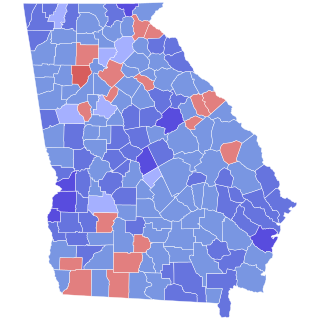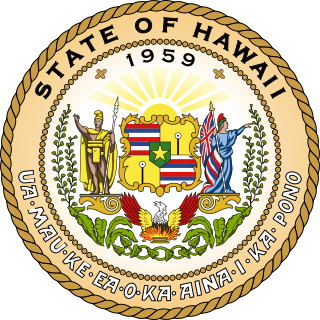
The 1984 United States Senate elections were held on November 6, with the 33 seats of Class 2 contested in regular elections. They coincided with the landslide re-election of President Ronald Reagan in the presidential election. In spite of the lopsided presidential race, Reagan's Republican Party suffered a net loss of two Senate seats to the Democrats, although it retained control of the Senate with a reduced 53–47 majority.

The 1998 Massachusetts gubernatorial election was held on November 3, 1998. Acting Governor Paul Cellucci was elected to his first term as Governor of Massachusetts.

United States gubernatorial elections were held on November 5, 2002, in 36 states and two territories. The Republicans won eight seats previously held by the Democrats, as well as the seat previously held by Minnesota governor Jesse Ventura, who was elected on the Reform Party ticket but had since renounced his party affiliation. The Democrats won 10 seats previously held by the Republicans, as well as the seat previously held by Maine governor Angus King, an independent. The elections were held concurrently with the other United States elections of 2002.

The 1990 Georgia gubernatorial election was held on November 6, 1990. Lieutenant Governor Zell Miller ran for governor after incumbent Joe Frank Harris was term-limited, defeating Andrew Young, Roy Barnes, and Lester Maddox for the Democratic nomination, and defeated Johnny Isakson, a member of the Georgia House of Representatives. As of 2022, this is the last time that Dade, Walker, Whitfield, Murray, Gilmer, Fannin, Floyd, Gordon, Pickens, Dawson, Forsyth, Hall, Barrow, Jackson, Madison, White, Walton, Paulding, Carroll, Coweta, Troup, Spalding, Pike, Harris, Glynn, Camden, Bryan, and Effingham counties voted for the Democratic candidate for governor.

The 1994 United States Senate special election in Tennessee was held November 8, 1994. Incumbent Democratic Senator Al Gore resigned from the Senate following his election as Vice President of the United States in 1992, and this led to the 1993 appointment of Harlan Mathews and the subsequent special election. Mathews did not seek election to finish the unexpired term, and Representative Jim Cooper subsequently became the Democratic nominee. However, the Republican nominee Fred Thompson won the seat in a decisive victory.

The 1984 Arkansas gubernatorial election was held on November 6, 1984. Incumbent Governor Bill Clinton won reelection with a 25% margin of victory over Jonesboro businessman Woody Freeman. This was the last gubernatorial election in Arkansas before the implementation of Amendment 63, lengthening the term of the governor of Arkansas from two to four years. Winning his third of five terms as Governor of Arkansas, Clinton continued to serve this office until shortly after he was elected to the presidency in 1992.

The 2014 Tennessee gubernatorial election took place on November 4, 2014, to elect the governor of Tennessee, alongside other state and local elections. Incumbent Republican governor Bill Haslam was re-elected to a second term with 70.3% of the vote, defeating his Democratic challenger Charles Brown. Improving on his performance from 2010, Haslam also carried every county in the state.

The 1978 Illinois gubernatorial election was held on Tuesday, November 7, 1978. Republican James R. Thompson easily won a second term in office, defeating Democratic nominee Michael Bakalis by nearly 600,000 votes.

The 1959 United States Senate elections in Hawaii were held July 28, 1959. Following the admission of Hawaii as the 50th State in the union, the state held 2 simultaneous elections to determine its first senators.

The 1916 United States Senate election in Tennessee was held on November 7, 1916. Incumbent Democratic Senator Luke Lea ran for re-election to a second term, but was defeated for the Democratic nomination by U.S. Representative Kenneth McKellar. McKellar won the general election against Republican Governor of Tennessee Ben W. Hooper.

The 1966 United States Senate election in Tennessee was held on November 8, 1966, concurrently with other elections to the United States Senate in other states as well as elections to the United States House of Representatives and various state and local elections. Republican nominee Howard Baker won the election, defeating Democratic nominee and Tennessee Governor Frank G. Clement with 55.7% of the vote.

The 1799 Tennessee gubernatorial election took place from August 1–2, 1799. Incumbent Democratic-Republican governor John Sevier was re-elected to a third term almost unanimously with 99.74% of the vote, against two opponents.
Democrat William Proxmire won a special election to fill the vacancy created by the death of Senator Joseph R. McCarthy (R-WI). Also, Price Daniel (D-TX) left the Senate to become governor of Texas, and Democrat Ralph Yarborough won a special election for that Senate seat. The Democrats thus made a net gain of one seat. However, Congress was out of session at the time of the Democratic gain in Wisconsin, and the Republicans gained a Democratic-held seat only weeks after the next session started, when Republican John D. Hoblitzell Jr. was appointed to fill the vacancy created by the death of Senator Matthew M. Neely (D-WV).

The 1892 Tennessee gubernatorial election was held on November 8, 1892. Democratic nominee Peter Turney defeated Republican nominee George W. Winstead, and Incumbent Governor John P. Buchanan, who ran as a Populist, with 47.86% of the vote.

The 1888 Tennessee gubernatorial election was held on November 6, 1888. Incumbent Democratic governor Robert Love Taylor defeated Republican nominee Samuel W. Hawkins with 51.78% of the vote.

The 1874 Maine gubernatorial election was held on September 14, 1874. Republican candidate Nelson Dingley Jr. defeated the Democratic candidate Joseph Titcomb.

The 1998 Georgia lieutenant gubernatorial election was held on November 3, 1998, to elect the lieutenant governor of Georgia, concurrently with the 1998 gubernatorial election, as well as elections to the United States Senate and elections to the United States House of Representatives and various state and local elections. Georgia is one of 21 states that elects its lieutenant governor separately from its governor.

The 1994 Georgia lieutenant gubernatorial election was held on November 8, 1994, to elect the lieutenant governor of Georgia, concurrently with the 1994 gubernatorial election, as well as elections to the United States House of Representatives and various state and local elections. Georgia is one of 21 states that elects its lieutenant governor separately from its governor.

The 1796 Tennessee gubernatorial election was held between 1 and 2 March 1796 in order to elect the first governor of Tennessee. Democratic-Republican nominee and former member of the U.S. House of Representatives from North Carolina's 5th district John Sevier ran unopposed and thus won the election, but the exact election results are unknown.

The 1827 Tennessee gubernatorial election was held between 2 and 3 August 1827 in order to elect the governor of Tennessee. Democratic candidate and former Jacksonian member of the U.S. House of Representatives from Tennessee's 7th district Sam Houston defeated Democratic-Republican candidate and former member of the U.S. House of Representatives from Tennessee's 5th district Newton Cannon and former Democratic-Republican governor Willie Blount.
















